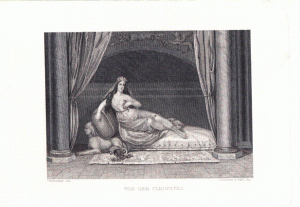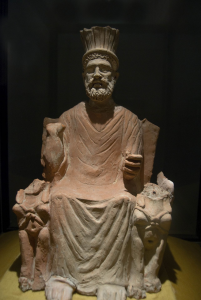Zwecker, Johann Baptist (1814–1876), ‘Tod der Cleopatra’ ca. 1840, copper engraving, 14 x 21,8 cm. (page, image: 10 x 13,9 cm.) engraved by Georg Friedrich Karl Deucker (1801-1863) Frankfurt from: Strahlheim, C., ‘Das Welttheater, oder die allgemeine Weltgeschichte von der Schöpfung bis zum Jahr 1840, Frankfurt am Main 1834, vol.3, p. 527 (496)
Sphinxes serve well as support. This quality developed from prehistoric times when neolithic goddess were seated on feline thrones. The feature passed on to various bronze age goddesses we know by name: Innanna-Ishtar, Isis, Sachmet and the Minoan godess who developed to Cybele in the iron age.1 It was succesfull: Lana del Rey paraphrases the phenomenen when being flanked by two living tigers in her videoclip ‘Born to die’ from 2011-12, here is a link: https://www.youtube.com/watch?v=ihu6Y8uVfTo
The function is interpreted as the protection the fierce animals gave to the deities, but the seat also implied a devine control over the earth’s most wild predators. Over the years, the lion’s manes were associated with the sun, the sun god and the male:2 in the exhibition ‘Carthago’ in the Museum of Antiquities in Leiden a terra cotta statue shows the Punic deity Baal Hammon, chief deity of air and war, enthroning between two sphinxes.
Punish Carthage, ‘Baal Hammon’, 1C AD, terracotta statuette, original finding place: Thinnisch sanctuary, inv.nr. B19, Musee Internationale Bardo, Tunis
In Western art, the sphinx throne was used as an indicator for pagan rulers like Solomon, but especially the last queen of Egypt could claim this specific furniture decoration: the sphinx had a pharaonic origin. Like Zwecker depicted Cleopatra in 1834, showing her reclining on her death bed while holding the lethal snake to her breast. A big pillow leans against the protector.
Notes:
1. Baring, Anne en Jules Crashford, The Myth of the Goddess. London 1991
Johnson, Buffie, Lady of the beasts: ancient images of the goddess and her sacred animals. San Francisco, 1988
2. Kemp, Martin, The human animal in western art and science. Chicago/London 2007, p.39.
More information on the book:
http://explore.bl.uk/primo_library/libweb/action/search.do?dscnt=1&scp.scps=scope%3A%28BLCONTENT%29&frbg=&tab=local_tab&dstmp=1428333505969&srt=rank&ct=search&mode=Basic&cs=frb&dum=true&tb=t&indx=1&doc=BLL01003520629&vl(freeText0)=003520629&fn=search&vid=BLVU1&fromLogin=true
All images in the book:
http://flickrhivemind.net/flickr_hvmnd.cgi?method=GET&page=6&photo_number=50&tag_mode=all&originput=pubplacefrankfurtammain&search_type=Tags&sorting=Interestingness&photo_type=250&noform=t&search_domain=Tags&sort=Interestingness&textinput=pubplacefrankfurtammain

